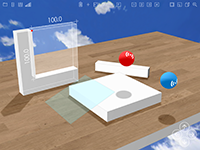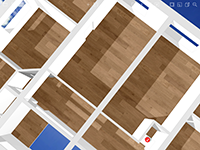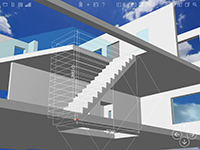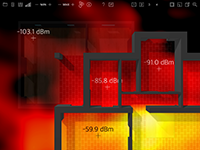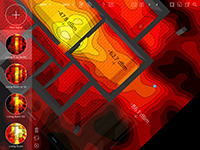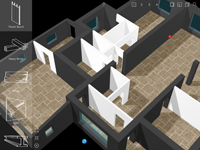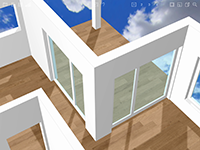Signal3D
Signal3D implements radio frequency ray tracing for indoor environments. It offers a 3D user interface to define environment geometry and visualize signal prediction. The embedded Discrete Method of Images. can be used to improve wireless signal coverage in indoor environments, such as apartments, homes or offices. In-depth signal analysis is possible by connecting to our RTX service, which is capable of computing narrowband channel impulse responses between two points in space.
Scene Geometry Description
In order to simplify indoor environment description only wall-like building block is needed. Each wall may have several openings, which can be optionally filled with glass or opaque panel. Complex geometries can be defined using only this single type of primitive while providing user interface with fast learning curve. In addition to walls, scene includes two sphere-shaped dipole antennas, the red one indicating the access point location and the blue one defining the signal observation plane. Optional floorplan can be shown if provided by user.
About DMI
Method of images (MI) is one of the oldest methods for radio wave propagation prediction based on the ray-tracing principle. Although the MI was originally restricted to the environments with prevailing reflection phenomena, it is also used in indoor scenarios in which through-wall transmission make a significant contribution to the received signal power. Discrete Method of Images (DMI) takes advantages of fast graphical 3D rasterization for fine-grained parallelism while computing radio-frequency signal loss. MI's traditional algebraic treatment of bounding regions and surfaces is replaced by computer graphics rendering of 3D reflections and double refractions while building the image tree. Further, the visibility of reception points and surfaces is resolved by shaders. The rendering resolution may be scaled back for a given level of scenario detail with only marginal impact on the image tree size. This allows selection of scene optimized execution parameters for faster execution, giving the method a competitive edge. The DMI can be executed on any GPU with OpenGL support.
RTX
RTX is our full 3D radio frequency ray tracing server based on the brute force shooting and bouncing rays. It is freely available as a remote service through Signal3D. The service may be occasionally unavailable due to high load and limited computing capabilities. Please contact the author if you want to run RTX locally.
The simulator effectively traces a large number of rays from the transmitting source in all directions into the scene. As opposed to the more common 2D or 2.5D approaches it was designed as a full 3D simulator. The initial set of rays launched into the scene needs to be separated uniformly as much as possible, thus icosahedral grids are used with well-defined rays' space distribution. Using geometrical optics concepts in describing radio frequency propagation implies that initial rays are an abstraction of a single wavefront spreading into space. Subsequent electromagnetic interactions with matter initiate new wavefronts, described by another sets of reflected, refracted, diffracted or scattered rays. The signal evaluation at given observation point combines these wavefronts freely, in the same way as if they are being transmitted by multiple independent sources.
Reflection and refraction phenomena on the boundaries between propagation media are modelled using Fresnel equations for electric and magnetic field amplitudes, taking into account incident angle and electric field polarization. Modelling edge diffraction is done using the geometrical theory of diffraction, meaning that wavefront rays passing in close vicinity to a diffraction edge produce a number of diffracted rays on the surfaces of Keller cones. The simulator detects a ray close to a reception point and thus a wavefront by introducing a sphere object with variable non-zero radius and by inspecting the intersecting rays. Bloom filtering is used to select unique wavefronts. Further, the antenna dipole patterns, the attenuation caused by the propagation through material as well as the signal spreading loss are accounted for. Multipath components of a narrowband impulse response are thus readily available as delayed signal phasors.
GPU Implementation
The server is based on the NVIDIA OptiX ray-tracing engine, which is adapted to the radio frequency simulations and runs entirely on GPUs. Scene objects are kept in a bounding volume hierarchy, with rays generated and traced in parallel threads. Tasks such as ray generation, handling of scene objects, finding intersection points and others are performed by the GPU's vendor library, which is commonly used in high performance real-time computer graphic techniques.
References


